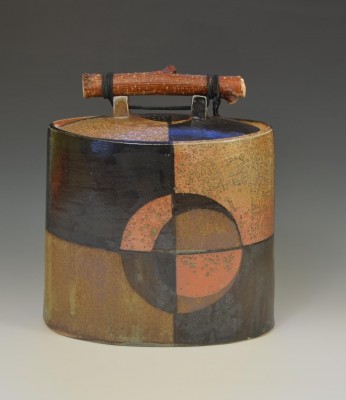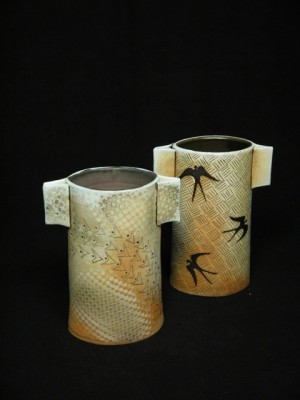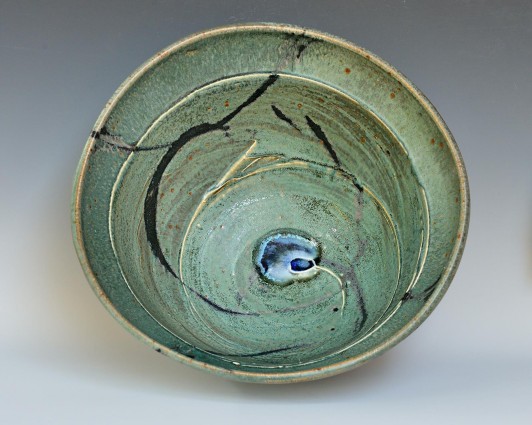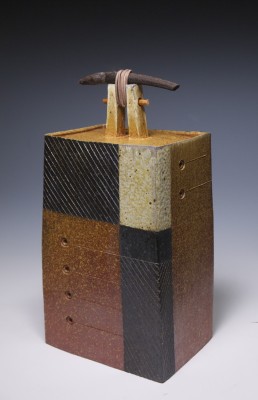Exactly how a ceramicist can wrestle a lump of clammy clay into an inspired art form takes crazy dedication. And for the students and their teachers exhibiting at “2016 Inspiration to Completion” at Glen Echo Park’s Popcorn Gallery from May 14 through June 12, that’s what it’s all about.

Ceramicist Elka Adamowisc of Bethesda has been working in the medium for 14 years, but mastering the potter’s wheel took some two years before she could comfortably begin creating original art. Taking the time to learn the fundamentals is critical, explained Jeffrey Kirk, Glen Echo Pottery’s director and the self-described “judge and jury” for this exhibition. “It’s easy for an inexperienced ceramicist to create funky organic pieces that also are contrived.”
When searching for inspiration, artistic newbies sometimes commit the gravest of sins: creating an artwork derivative of other artists’ work. “That happens quite a bit around our studio,” Kirk said. The students “must take some of their [other artists] ideas and make it their own. It’s very difficult to pull that off successfully. It is quite common throughout history that someone will steal someone else’s ideas, but if you make it too apparent, then the piece loses all credibility. It is a little bit of a dilemma for some artists and students.”
But not for Adamowisc. Although she finds inspiration in multiple artists’ work, she always seeks to find her own voice. Like other ceramic artists in this exhibit, she has taken workshops with potter Sequoia Miller, whose ability to maneuver a thrown cylindrical pot into something entirely different fascinated her. Adamowisc’s inspiration does not stop with just this artist; the civil engineer-by-day also appreciates how abstract painter Vasily Kandinsky used color and bold geometric forms. While both artists’ techniques can be seen as influences in Adamowisc’s work, she has managed to produce unique vessels. “I don’t copy their work,” the Bethesda resident emphasized.

Inspiration can come from almost anywhere–as much from reading a sonnet by Shakespeare or listening to acid rock as from gazing at a ceiling at the local Starbucks. “Ductwork can be very interesting,” Kirk said. “You have to be in tune with your environment and get in the habit of connecting.”
Kirk encourages his students to “create organic Zen-like, but not contrived pieces. They should be unique and spontaneous.” The pottery needs to “look like it evolved on its own.”
He readily admitted his own goal is to reference the Japanese garden aesthetic, hoping to inspire students and remember their simplicity. While this is no small feat, Marsha Slater, a ceramicist who has taken Kirk’s classes multiple times, believes the potter inspires his students by creating small vignettes using natural materials and placing them in strategic spots in the domed yurt studios and the surrounding garden area.

Slater also finds inspiration while traveling the globe for her work as an international development consulate. The Arlington, Va., resident has always been captivated by the colorful textile patterns worn in east Africa and the textured baskets she sees in South America. Last year, while traveling to Japan, she became enamored with kimonos.
Before her trip, Slater had only seen them hanging, static on a wooden rod, but in Japan, she was amazed by how they different they appeared when worn by the native women. She noticed the fluidity of the fabric and how images of water and birds on the fabric seemed to come alive. Producing the same movement in her pottery became her goal. She used a medical scalpel that enabled her to make precise incisions, and then created intricate patterns that encircle her vessels.
Slater’s evolution as a ceramic artist also came from enrolling in multiple summer master pottery workshops in Colorado and North Carolina. “I wanted to be inspired by others outside of my studio, which can be rather insular,” she said. Fortunately, inspiration doesn’t require an airplane ride or an advanced tutorial. She recalled recently watching Kirk teach a technique to an intermediate class and was “mesmerized.”
With the various classes and demonstrations, she is always concerned with finding her own voice. “I never want to copy the master,” she said.

Architect Michael Poness takes his day job to the pottery studio. “I make lidded vessels and put a roof on them,” he laughs, speaking by phone from his office in Greenbelt, Md. With 43 years of experience as a working architect, this Catholic University alumnus believes the discipline of doing architecture has helped him stay focused when creating his vessels.
Poness’ inspiration often comes from observing the piers and pylons that keep buildings high above the incoming tide at the Atlantic shore, an area he often visits. And with a hectic schedule, he cannot waste time smacking the clay around while searching for his vision. He keeps a sketchbook handy and makes scores of drawings. Once the potter sits down to work, he knows exactly what he will do. And it seems to work. His work is currently on sale at both Glen Echo Park and the Renwick Museum Shop in Washington, D.C.
The path to self-discovery and artistic expression can be rough, but “wrong roads are part of the learning curve. It can lead to a dead-end, and that is a good thing,” Kirk said.
“2016 Inspiration to Completion” will be on view at The Glen Echo Pottery Show will be on view Saturday and Sunday, noon to 6 p.m. and by appointment from May 12 through June 12 at The Popcorn Gallery at Glen Echo Park, 7300 MacArthur Blvd., Glen Echo. Admission is free. Call 301-229-5585.